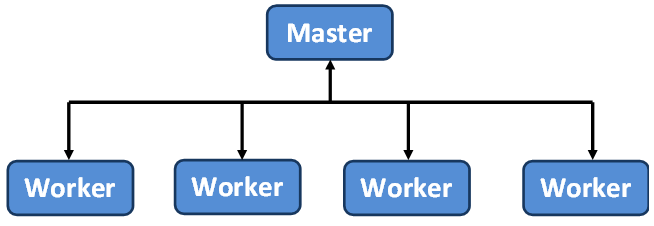Splitting problems up into tasks and running these concurrently over a number of cores is a popular approach to parallelism. In recent years this has becoming more and more popular and is seen as one of the ways in which parallel codes might be written for future machines with very large numbers of processing cores. In this tutorial we are going to look at this task approach and using ePython it is very simple to send tasks around between the Epiphany cores.
These tutorials use ePython, which is a subset of Python that runs on the Epiphany and allows us to quickly write and run some code. Before going any further if you have not yet used or installed ePython then it is worth following the instructions (here) which walks you though running a simple “hello world” ePython example on the Epiphany cores. If you installed ePython a while ago then it is worth ensuring that you are running the latest version, instructions for upgrading are available here.
Remote procedure calls
Remote Procedure Calls (RPC) is where a core will execute a function remotely, i.e. on another core, providing the arguments to that function and then obtaining any results from its execution. In Python functions are known as first class, which means that they can be referred to like any other value and even communicated between the Epiphany cores.
import parallel
if (coreid()==0):
send(functionToRun, 1)
send(50, 1)
print recv(1)
elif (coreid()==1):
op=recv(0)
arg=recv(0)
returnVal=op(arg)
send(returnVal, 0)
def functionToRun(a):
print "Running on core 1 "+a
return a+10
In this code there is a function called functionToRun, which takes one argument and returns a value. Core 0 sends this function over to core 1, along with the argument and then await a message back from core 1 which it will then display. Core 1 receives the function, stores it in (op), then receives the argument from core 0 to pass into the function (into arg variable), it then executes the function and sends back the returned value to core 0.
In this approach we can communicate any functions, any number of arguments and send returned values back from any cores. However there is a problem with how we have written this, namely the fact that for core 0 this is blocking, i.e. it sits idle and waits for the returned value whilst the function is being executed on core 1. This isn’t ideal and not particularly parallel because there might be other functions which core 0 wants to execute on other cores but it can not until this specific function has completed….. so what can we do to improve this?
The taskfarm module
We have seen so far that you can send functions around and execute them on other cores, but we don’t want a core blocking (i.e. stalling and waiting from the results of a function without doing anything else.) ePython comes with the taskfarm module which provides a way of farming tasks out to other cores and avoids this issue of blocking for the function to complete executing. So now lets rewrite the first example but instead using the taskfarm module.
import parallel
import taskfarm
initTaskFarm(0)
if (coreid()==0):
execFunction(1, functionToRun, 50)
if (testFunctionFinish(1)):
print "The function has executed"
else:
print "The function is still running"
print waitFunctionFinish(1)
shutdownTaskFarm()
else:
worker()
def functionToRun(a):
print "Running on core 1 "+a
return a+10
The first function call initTaskFarm will initialise the task farm and the argument determines which core is the “master”, i.e. which will instruct other cores to execute what functions. Every core which is not the master (in this case every core whose id is not 0) is known as a “worker” and will call the worker function, which waits for either functions to execute (and then executes them) or for the task farm to shut down. Core 0 then calls execFunction which instructs the task farm to execute the functionToRun function on core 1 (the first argument) with the value of 50. This execFunction call is non-blocking, this means that it will return as soon as the required data has been communicated to core 1 rather than when core 1 has finished executing the function itself. It is possible to determine the progress of a remotely running function on a core via the testFunctionFinish call and the waitFunctionFinish will wait for function completion on a core and return any returned values from that function. The testFunctionFinish function just returns true or false (representing whether the remote function has finished executing) so if you use this test, even if this call returns true, then you will still need to call waitFunctionFinish to retrieve any returned value. The shutdownTaskFarm is called from the master to command the worker cores to shutdown once they have finished running any current functions.
As an exercise extend this example to run multiple functions over multiple worker cores (hint, if you get stuck then have a look at the task_farm_example.py which illustrates how to do this.)
Master-worker

In the previous section we used the terminology of “master” and “worker”, this is a common approach in parallelism where one core (in our case that with the core id provided to the initTaskFarm function) is the master, dishing out work to all other other cores which are workers. You can see this in the diagram to the right, where the master sends out tasks and data to the workers which then execute these and send back any results and inform the master they have completed (and hence can accept another task.) Many parallel problems can be split up into tasks and this approach of master and worker. So now let’s rewrite the estimation of PI via Monte Carlo method (in the parallel messaging tutorial) to instead use tasks, the taskfarm module and this general parallelisation strategy of master-worker.
import parallel
import taskfarm
import util
from math import pow
from random import random
initTaskFarm(0)
if (coreid()==0):
piVal=0.0
for i in range(1,numcores()-1):
execFunction(i, simulateDarts, 1000)
for i in range(1,numcores()-1):
piVal+=waitFunctionFinish(i)
print piVal/(numcores()-1)
shutdownTaskFarm()
else:
worker()
def simulateDarts(num_darts):
score=0.0
j=1
while j<=num_darts:
x=random()
y=random()
if (pow(x,2) + pow(y,2) < 1.0): score+=1
j+=1
return 4.0 * (score/num_darts)
In the code core 0 is the master, this then remotely executes the simulateDarts function on every other core concurrently (because execFunction is non-blocking), and then once each function has been scheduled to run on a worker core it will block for each remote function to complete (via the waitFunctionFinish function) and add the returned value to the running total of PI which is then divided to deduce the final value.
For reasons of simplicity for the example we are just executing the simulateDarts function once on each worker core, if you look at the PI example (here) in more detail you will see that this works in rounds. As an exercise extend the code here to include these rounds so there are multiple function calls on each worker core. Once you have got a simple version of this working then instead of waiting for every function in each round to complete before moving onto the next round, consider how you might use the testFunctionFinish to poll all workers and simply re-assign more work (i.e. calls to the simulateDarts function) as they become idle.
Summary
In this tutorial we have look at the concepts of tasks, remote procedure calls, task farms and master worker. It is often possible to rewrite many existing parallel codes in terms of distinct tasks which can be executed concurrently and this can form an alternative approach to parallelism. Whilst, for simplicity, we have focused on running a single task many times over all the cores (homogeneous), it is easy to see how one can provide additional functions and run tasks heterogeneously, i.e. very different tasks on different Epiphany cores. This can work well for some work loads and the tasks themselves can become quite complex and irregular, for instance involving communications.
About the author
Dr Nick Brown works at EPCC, which is the UK’s leading centre for HPC. Nick currently develops weather models that run over many thousands of cores and has research interests in programming language and compiler design. More information here.

